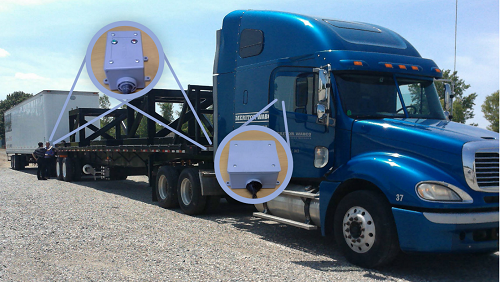New Technology Aims to Simplify Tractor-Trailer Fleet Management
There are 5.6 million tractor-trailers that haul 68 percent of all goods we receive, with an increased demand for expedited shipping and receiving. Since a tractor-trailer vehicle is comprised of both the tractor portion where the driver sits and the trailer that carries the goods, there are many pieces of equipment and vehicles for fleet operators to manage.
To help improve tractor-trailer location accuracy, Intelligent Automation Inc. (IAI) developed a new vehicle identification number (VIN) technology that can simplify fleet management.
The Automated Trailer VIN Identification and Sequencing System, known as TRAVIS, is a wireless tractor-trailer communication system that consists of a VIN transmitter unit placed on each trailer and a VIN receiver unit placed in the tractor. This system automatically identifies how many towed units are attached, as well as each unit’s VIN and license plate numbers. TRAVIS supports the optimization of the tractor’s on-board safety systems, wireless roadside inspection, wirelessly streamlining border crossing processes, and Smart-Park initiatives.

A close-up view of the TRAVIS VIN receiver and transmitter. The TRAVIS VIN receiver is located within the tractor cabin, while a VIN transmitter is located on each trailer. The app transmits the trailer’s VIN to the tractor to support the tractor’s on-board safety systems and wireless roadside inspection, wirelessly streamlining border crossing processes and Smart-Park initiatives. (Intelligent Automation Inc. photo)
Existing solutions are costly, cannot determine the sequence of the hauled trailers, and often do not work with legacy trailers. Using TRAVIS, fleet companies can track trailers, gather data, and facilitate the wireless roadside inspection process.
The key innovation of this system is a low-cost, easily deployable and rugged system that consists of two types of units: a trailer-based VIN transmitter and a tractor-based VIN receiver and interpreter connected through a wireless radio.
Fueling Small Business Expansion
IAI received funding to develop TRAVIS from the Federal Motor Carrier Safety Administration (FMCSA) as part of the U.S. Department of Transportation’s (U.S. DOT) Small Business Innovation Research (SBIR) program, administered by Volpe. The U.S. DOT SBIR program is a highly competitive, awards-based program that encourages domestic small businesses to engage in research or research and development (R/R&D), addressing high-priority research areas within U.S. DOT.
Since 2012, FMCSA has awarded $750,000 to IAI through the SBIR program to develop TRAVIS. IAI has regularly participated in various SBIR programs since its inception in 1987, helping the company expand and grow its transportation division in the last decade.
“Without SBIR funding, there are few resources to conduct innovative research and employ more talented people to improve services and products,” said Xiaoliang (George) Zhao, a senior program manager for IAI.
Looking Toward Future Growth
IAI engineers are actively working on continuous improvements of the TRAVIS prototype, including the following:
- Expanding the system capability
- Addressing areas of interest
- Developing more features in hopes of continuing to inform the connected vehicle movement
If deployed, the technology will support the productivity of fleet companies, as well as improve safety and mobility for the public. The developed system prototype has the potential to address many of U.S. DOT’s initiatives, such as onboard safety systems, wireless roadside inspection, smart parking, and commercial vehicle programs.

